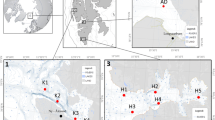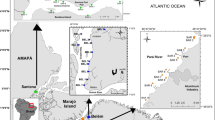Abstract
Three sediment cores were collected in the Venice Lagoon: two from mud flats (E, F) and one from the San Giuliano Canal (I1), which borders the industrial district. Samples were analysed for the 15 polycyclic aromatic hydrocarbons (PAHs) listed as priority pollutants by the U.S. EPA. Sediment chronologies were established using both 137Cs and 210Pb activity-depth profiles, and confirmed by independent information. The highest levels of PAHs, up to 16,474 μg kg−1, characterise the sediment from the industrial canal. In lagoon sediments maximums were 618–1,531 μg kg−1, while surficial values were 315 and 810 μg kg−1. Dated concentration-depth profiles suggest that highest inputs occurred in the first half of last century and were followed by significant decreases. The industrial activities played a major role in the PAH contamination of lagoon sediments, as suggested by the high concentration gradients in the study area. The main source, based on the information provided by the relative abundance of congeners, is represented by high temperature combustion processes. Petrogenic sources may have influenced some samples, whereas the effects of selective transport and diagenesis are difficult to assess. The sediment of the industrial canal has the potential to occasionally cause adverse effects in sensitive species.
Similar content being viewed by others
References
Baumard, P., H. Budzinsky, Q. Michon, P. Garrigues, T. Burgeot & J. Bellocq, 1998. Origin and bioavailability of PAHs in the Mediterranean Sea from mussel and sediment records. Estuar. coast. shelf Sci. 47: 77-90.
Bellucci, L. G., M. Frignani, S. Raccanelli & C. Carraro, 2000. Polychlorinated dibenzo-p-dioxins and dibenzofurans in surficial sediments of the Venice Lagoon (Italy). Mar. Poll. Bull. 40: 65-76.
Bellucci, L. G., M. Frignani, D. Paolucci & M. Ravanelli, 2002. Distribution of heavy metals in sediments of the Venice Lagoon: the role of the industrial area. Sci. Tot. Environ., in press.
Benlahcen, K. T., A. Chaoui, H. Budzinski, J. Bellocq & P. H. Garrigues, 1997. Distribution and sources of polycyclic aromatic hydrocarbons in some Mediterranean coastal sediments. Mar. Poll. Bull. 34: 298-305.
di Domenico, A., L. Turrio Baldassarri, G. Ziemaki, E. De Felip, C. La Rocca, G. Ferrari, M. Cardelli, F. Volpi, F. Ferri, N. Iacovella, C. Lupi, F. Rodriguez, O. D'Agostino, R. Sansoni & G. Settimo, 1998. Priority microcontaminants in sediment samples from the Venice Lagoon: a selection of concentration data and predominant analytical features. Organohalogen Compd. 39: 205-210.
Frignani, M., L. G. Bellucci, C. Carraro & M. Favotto, 2001a. Accumulation of polychlorinated dibenzo-p-dioxins and dibenzofurans in sediments of the Venice Lagoon and the industrial area of Porto Marghera. Mar. Poll. Bull. 42: 544-553.
Frignani, M., L. G. Bellucci, C. Carraro, & S. Raccanelli, 2001b. Polyclorynated biphenyls in sediments of the Venice Lagoon. Chemosphere 43: 567-575.
Hallet, D. J. & R. W. Brecher, 1984. Cycling of polynuclear aromatic hydrocarbons in the Great Lakes ecosystem. In Nriagu J. O. & M. S. Simmons (eds), Toxic Contaminants in the Great Lakes, Wiley, New York: 213-237.
Long, E. R., L. J. Field & D. D. MacDonald, 1998. Predicting toxicity in marine sediments with numerical sediment quality guidelines. Environ. Toxicol. Chem. 17: 714-727.
McCready, S., D. J. Slee, G. F. Birch & S. E. Taylor, 2000. The distribution of polycyclic aromatic hydrocarbons in surfi-cial sediments of Sidney Harbour, Australia. Mar. Poll. Bull. 40: 999-1006.
Pavoni, B., A. Marcomini, A. Sfriso, R. Donazzolo & A. Orio, 1992. Changes in an estuarine ecosystem. The Lagoon of Venice as a case study. In Dunnette D. A. & R. J. O'Brien (eds), The Science of Global Change. ACS Symposium Series 483, Washington: 287-305
Raoux, C. & P. Garrigues, 1993. Mechanism model of polycyclic aromatic hydrocarbons contamination of marine coastal sediments from the Mediterranean Sea. In Proceedings of the 13th International Symposium on Polynuclear Aromatic Hydrocarbons. Bordeaux, France, Gordon and Breach Publishers, Paris: 443-450.
Soclo, H. H., P. H. Garrigues & M. Ewald, 2000. Origin of polycyclic aromatic hydrocarbons (PAHs) in coastal marine sediments: case studies in Cotonou (Benin) and Aquitaine (France) areas. Mar. Poll. Bull. 40: 387-396.
Wakeham, S. G., C. Schaffner & W. Giger, 1980. Polycyclic aromatic hydrocarbons in recent lake sediments - II. Compounds derived from biogenic precursors during early diagenesis. Geochim. Cosmochim. Acta 44: 415-429.
Author information
Authors and Affiliations
Rights and permissions
About this article
Cite this article
Frignani, M., Bellucci, L.G., Favotto, M. et al. Polycyclic aromatic hydrocarbons in sediments of the Venice Lagoon. Hydrobiologia 494, 283–290 (2003). https://doi.org/10.1023/A:1025451307225
Issue Date:
DOI: https://doi.org/10.1023/A:1025451307225




